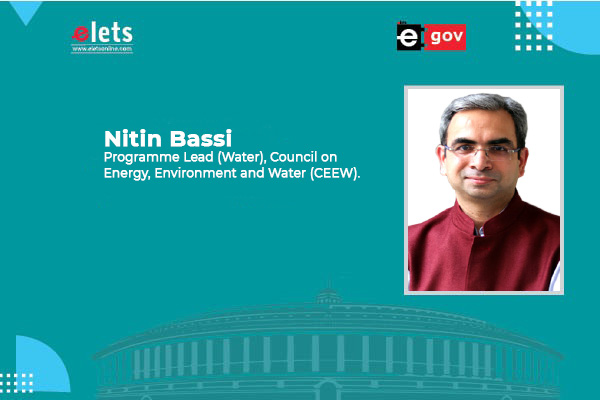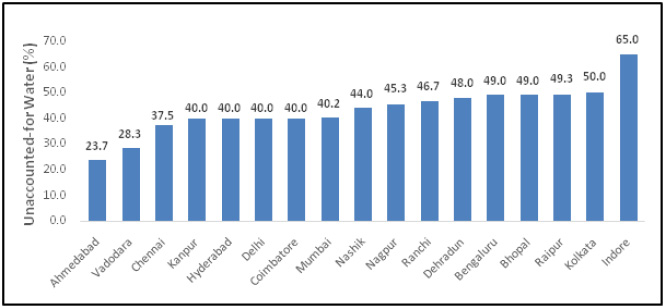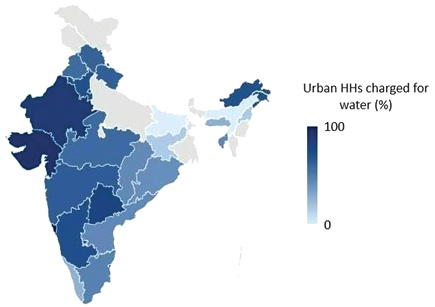
In line with the United Nation’s Sustainable Development Goal 6 ‘clean water and sanitation for all,’ the second phase of the Atal Mission for Rejuvenation and Urban Transformation (AMRUT 2.0) envisages providing tap water connections to households in all the statutory towns and sewerage services in 500 selected cities in India, writes Nitin Bassi, Programme Lead (Water), Council on Energy, Environment and Water (CEEW).
The targets under the AMRUT 2.0 translate into providing new tap connections to 26.8 million households and new sewerage services to 26.4 million households by 2026 for which an allocation of Rs 2,770 billion has been made by the Government of India, 2021.
This is an enormous challenge for water utilities in urban areas, where the existing water supply systems are unable to meet the domestic water demand due to system inefficiency and poor coverage. In some of the major cities in India, the unaccounted-for water losses, which are referred to as non-revenue water that includes leakages and non-billed consumption, vary from 40 per cent to 65 per cent of the total water production (Figure 1).


Figure 1: Unaccounted-for water losses (as a percentage of water produced) in selected cities of India (data range is from 2016 to 2021)
Source: Author’s analysis using data from the urban local bodies and the Centre of Water and Sanitation, CEPT University
The water supply is highly unreliable and intermittent with many cities receiving water only for two-three hours a day. In many suburban areas, public water supply and sewerage infrastructure are non-existing.
Once the physical infrastructure under AMRUT 2.0 is completed, water will be required for the new connections. This will need proper planning and both water supply augmentation and water demand management interventions.
Some of these are discussed henceforth.

Water Accounting and Water Balance
First of all, a city-level water account that provides the details on the amount of renewable surface water and groundwater available for supply, consumptive water use in the domestic sector, administrative and technical losses in water supply, and wastewater return flow during a particular year need to be prepared. Such exercise will help the water supply utilities in deciding the type of interventions (i.e., supply augmentation, demand management, or both) required to ensure household-level water security.
The AMRUT 2.0 has made a step in the right direction. It suggests cities prepare the City Water Balance Plans (CWBPs) which should provide the status of water sources, the quantum of water available, water demand and supply in the city, and the deficit. The ultimate aim of preparing CWBPs is to formulate projects to address the water deficit. Water supply utilities should take up preparing water accounts and water balances as a priority.
Augmenting Supplies
Due to the unregulated pumping from the aquifers in urban and peri-urban areas, most of the annual renewable groundwater is utilised before the onset of summer. The situation becomes critical during the dry years when the recharge itself is low. In several urban areas, groundwater is unfit for domestic use due to the presence of harmful contaminants including heavy metals. Already, many cities are dependent on surface water reservoirs located in the far-off catchments for the domestic water supply. Major parts of Delhi get water from a source which is about 220 km away in Haridwar through the upper Ganga canal; Bengaluru from the Cauvery River at a distance of about 100 km; and Hyderabad from Krishna and Godavari rivers, with withdrawal sources located several hundred kilometres away. As the cities continue to grow, the distance of transfer has only been increasing. Only a small proportion of the water supply in such cities is met by local water sources which include lakes, and wells. For instance, in Delhi, less than 10 per cent of the total water supply is from groundwater.
Thus, to ensure year-round domestic water supply to the urban households, provision needs to be made to ensure that the local water resources are augmented. Importing surface water from distant reservoirs is one option. Considering such a situation, investments are required not only for individual household connections but also for the conveyance of water from a distant source.
Sewage Treatment and its Reuse
As per the estimates of the Central Pollution Control Board (CPCB), about 72,368 million litres of sewage is generated per day from urban centres in India (CPCB, 2021). However, the capacity exists to treat only 44 per cent of this. The sewage treatment capacity in the metropolitan cities is substantially higher (51 per cent) than in Class I cities and Class II towns where it is 18 per cent and 9 per cent, respectively. Nevertheless, there is a need for expanding the treatment infrastructure, thereby increasing the availability of treated wastewater that can be made available for reuse.
The AMRUT 2.0 envisages that at least 20 per cent of the city water demand and 40 per cent of the total industrial water demand at the state level should be met by treated wastewater. Though there is a social stigma attached to reusing treated wastewater in households, some states in India (including Chhattisgarh, Gujarat, and Haryana) have framed policies to promote treated wastewater for industrial and other non-potable purposes (public parks, gardens, etc.). Nevertheless, with highly variable rainfall and growing urban water demand, the time has come to make it mandatory for groundwater recharge (using natural lakes or artificial reservoirs as recharge structures) and for agriculture in urban areas. Subsequently, with the use of better treatment technologies, efforts should be made to bring treated wastewater to a quality that is acceptable to the community for human consumption.

Figure 2: Percentage of urban households (HHs) that are connected to public water supply and charged for water in each state, 2017-18
Source: Prepared by the author based on data presented in Government of India, 2019 Note: Jammu and Kashmir, Ladakh, Manipur, Mizoram, Sikkim, Uttar Pradesh, and West Bengal did not report data.
Water Pricing
The AMRUT 2.0 envisages reducing non-revenue water to below 20 per cent. The need for reducing unaccounted-for water losses and promoting efficient water use through installing household water meters and pricing of water that includes resource cost, the cost of water treatment, and cost of conveyance and distribution, has been suggested in the past (Gordon- Walker and Jalakam, 2011; Bassi and Kumar, 2012; Kumar, 2014). Yet most Indian cities are struggling hard to implement them due to a lack of political commitment (fear of losing votes if domestic water is priced), the absence of an institutional framework for proper pricing, and the shortage of human resources for meter reading and billing.
Though a substantial proportion of the urban households are charged for public water supply at present (except for some eastern and north-eastern India) (Figure 2), water tariffs for domestic consumption have remained highly subsidised leading to its inefficient use. Even in the National Capital Territory (NCT) of Delhi where the annual per capita income is among the highest in the country, 20 cubic metres of water is provided free to each household having metered connection every month. As a result, about 68 per cent of such households get a ‘zero’ bill. It is high time that water tariffs are revised and water usage is charged on a volumetric basis. The water regulatory authority should play an increasing role in setting the water tariff for various purposes including domestic water consumption. From the long-term perspective, the water tariffs should be able to cover operation and maintenance costs, water supply infrastructure repayment, and contribute to capital development. To ensure water security for marginalised households, targeted subsidies can be provided to those who are below the poverty line or in the economically weaker category once they are connected to the public water supply. Presently, many such households pay more for water as they have to depend on informal private vendors to meet their water demand.
Conclusion
Drinking water security is the foremost requirement and most crucial for the well-being of society at large. The AMRUT 2.0 has taken a step in the right direction by aiming to connect all the urban households with individual tap connections. However, given the climate variability and increasing water demand from the urban areas, the water supply sources must be sustainable to ensure a year-round supply. Preparing city-level water accounts and water balance can guide the urban water utilities on the type of interventions that might be needed. In terms of supply augmentation, imported surface water appears to be the best bet. Further, the reuse of treated wastewater for non-potable purposes (initially) and recycled water for potable purposes (with the improvement in technologies) can reduce pressure on freshwater resources. However, the metering of water connections and appropriate pricing is crucial to encourage efficient use of water and manage the water demand. These pathways offer a great potential to realise the dream of providing a 24X7 water supply to all urban households in India.
Be a part of Elets Collaborative Initiatives. Join Us for Upcoming Events and explore business opportunities. Like us on Facebook , connect with us on LinkedIn and follow us on Twitter, Instagram.











